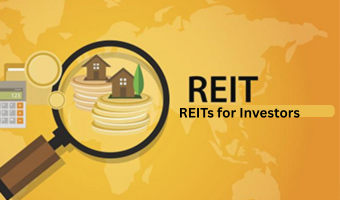REITs Explained for Investors
Read latest blogs and articles from Housystan

The Information mentioned here was last updated on:
11/12/2025REITs Explained for Investors: A Clear Guide to Real Estate Investment Trusts.
Real estate has long been seen as one of the most reliable ways to build wealth, but buying and managing property directly is not always practical. Many investors don’t want the responsibilities that come with being a landlord, nor do they have the large amount of capital needed to buy buildings on their own. This is where Real Estate Investment Trusts, better known as REITs, come into the picture. REITs make it possible to invest in property without ever having to buy a house, apartment, or office building yourself.
- Verified Tenants/Buyers
- Unlimited Property Listing
- Zero subscription/charges fee
A REIT is a company that owns, operates, or finances income-producing real estate. What makes REITs unique is that they are required by law to distribute most of their taxable income back to shareholders, usually in the form of dividends. This structure makes them one of the most accessible and income-friendly investment options available to the everyday investor.
REITs pool money from many investors and use that capital to purchase or finance large real estate projects. These can include apartment complexes, warehouses, shopping centers, data centers, cell towers, office buildings, hotels, and sometimes even specialized assets like healthcare facilities.
When these properties generate income through rent or long-term leases the REIT pays out the majority of that income to its shareholders. Investors receive these payments as dividends, and they also benefit from any rise in the value of the REIT’s shares over time.
Investors buy shares of a REIT the same way they would buy stock in any publicly traded company. Many REITs are listed on major stock exchanges, which means you can buy or sell your position whenever the market is open. This liquidity is one of the biggest advantages compared with owning physical real estate, which can take months to buy or sell.
Although all REITs focus on real estate, they do not all operate the same way. Understanding the main types can help investors decide which ones match their goals and comfort level.
1. Equity REITs
These are the most common type. Equity REITs own and manage income-producing real estate. They collect rent from tenants and distribute profits to shareholders. For example, a residential REIT may own thousands of apartments across multiple cities, while an industrial REIT may own logistics warehouses used by major retailers.
2. Mortgage REITs (mREITs)
Instead of owning properties, mortgage REITs provide financing for real estate by buying or issuing mortgages. They earn money from interest. While they often pay higher dividends, they can also be more sensitive to changes in interest rates.
3. Hybrid REITs
Hybrid REITs combine the strategies of equity and mortgage REITs. They own physical properties but also invest in mortgages, creating a blend of rental income and interest income.
Regular Income
One of the biggest attractions is the steady flow of dividend income. Because REITs must distribute at least 90 percent of their taxable income to shareholders, they often offer higher dividend yields compared with many traditional stocks.
Diversification
By adding real estate exposure to a portfolio, investors spread their risk across different sectors. Real estate often behaves differently from stocks and bonds, which may reduce overall volatility.
Lower Entry Cost
Buying a commercial property requires significant capital. A REIT allows investors to access large-scale real estate for the price of a single share.
Professional Management
Investors do not need to deal with property maintenance, tenant issues, or negotiating leases. Experienced teams handle these responsibilities.
Liquidity and Flexibility
REIT shares can be bought or sold quickly through a brokerage account, making them far more flexible than owning buildings directly.
Factors to Consider Before Investing in REITs
Although REITs offer many advantages, they are not risk-free. Understanding what drives their performance can help investors make informed decisions.
Interest Rate Sensitivity
Because REITs often rely on borrowing, higher interest rates can raise their costs and potentially reduce profits. Additionally, when interest rates climb, income-focused investors sometimes shift money toward bonds, which can put pressure on REIT share prices.
Market Conditions
The value of a REIT depends on the health of the real estate sector it focuses on. For example, office REITs may be affected by shifts toward remote work, while retail REITs may feel pressure from the rise of online shopping. On the other hand, data center or industrial REITs may benefit from growing demand for cloud computing or e-commerce.
Dividend Taxation
Dividends from REITs are taxed differently from those of regular stocks, and this can affect a long-term investor’s returns. Many people choose to hold REITs in tax-advantaged accounts to reduce the tax burden.
Management Quality
As with any company, strong leadership plays a major role in performance. Investors should look at a REIT’s track record, occupancy rates, debt levels, and consistency of dividend payments.
Getting started is straightforward. Investors can buy shares of individual REITs through a brokerage account. Those who prefer instant diversification can also invest in REIT mutual funds or exchange-traded funds (ETFs), which hold baskets of various REITs across different property types.
When choosing a REIT, investors often look at dividend history, property type, geographic exposure, management reputation, financial strength, and overall growth strategy. Taking time to compare options can help align the investment with one’s personal goals, whether the priority is income, long-term growth, or a balance of both.